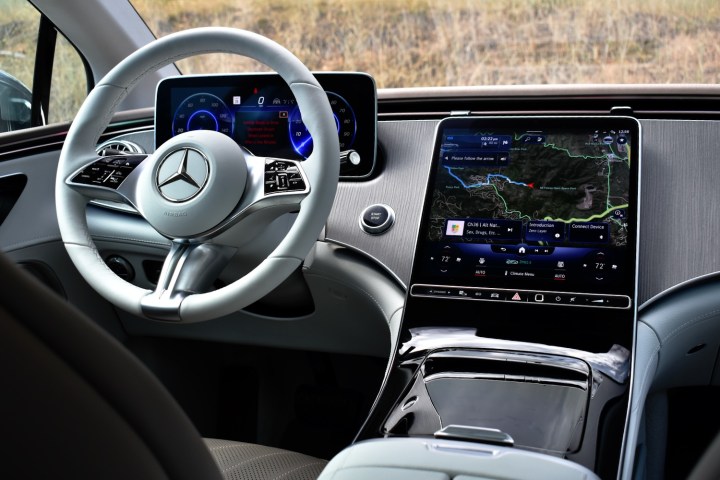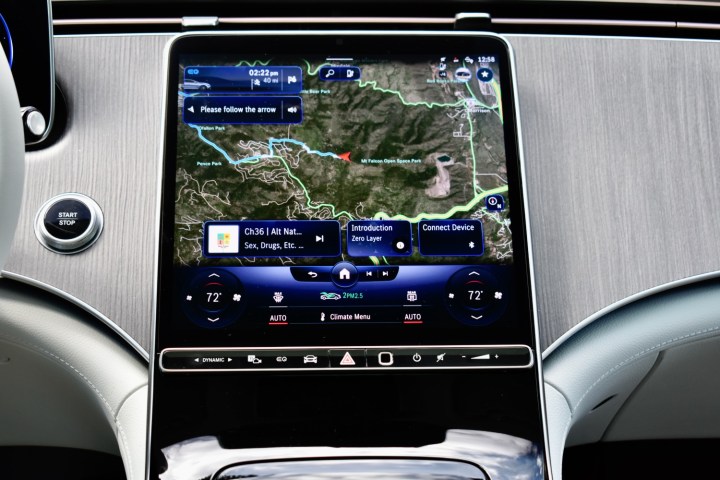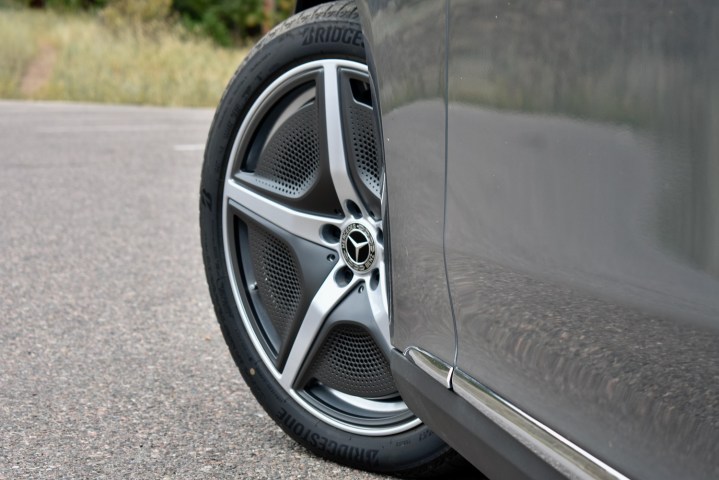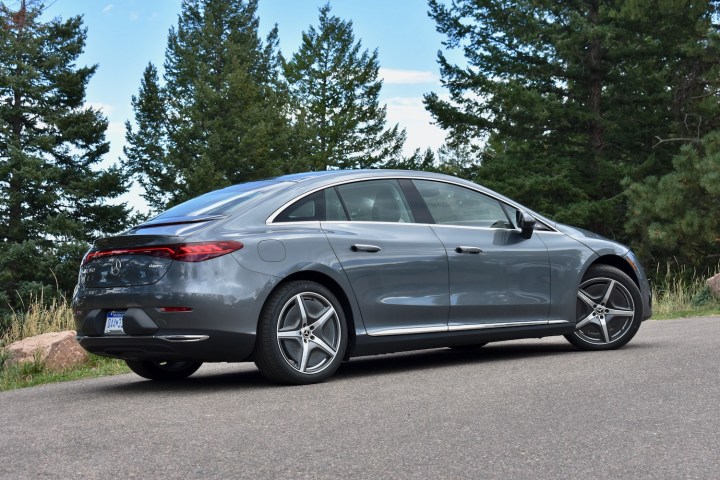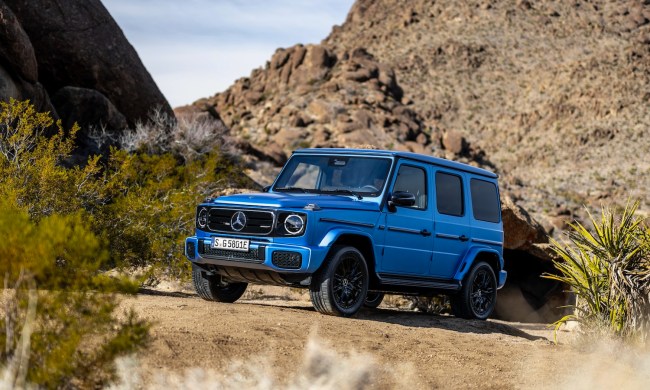Mercedes-Benz wants its EQ sub-brand to be an all-electric counterpart to its current lineup of gasoline luxury cars, and it’s working toward that goal by starting at opposite ends of the price spectrum and working toward the middle.
Where the EQS sedan and SUV are the flagships of the lineup, and the EQB serves as an entry-level offering, the 2023 Mercedes-Benz EQE sedan aims for the middle of the market. It’s pitched as an electric equivalent of the Mercedes E-Class, one of the automaker’s bread-and-butter models. And like the E-Class, the EQE will compete against sedans from Mercedes’ German rivals, such as the Audi e-tron GT, BMW i4, and Porsche Taycan. It will likely be cross-shopped against the Genesis Electrified G80, Lucid Air, and Tesla Model S as well.
The EQE sedan arrives at U.S. dealerships in late 2022 in four guises: base rear-wheel drive EQE 350+, all-wheel drive EQE 350 4Matic and EQE 500 4Matic, and an AMG EQE performance version. Mercedes hasn’t disclosed pricing for any of these models, but the EQE 350 4Matic we tested for this first drive will likely be a mid-tier trim level. Like its EQS sibling, the EQE will also get an SUV variant, which will launch sometime after the sedan version.
Design and interior
The EQE has the same lozenge-like shape as the EQS sedan, which is dictated by aerodynamics. The appeal of the design is up for debate, but the smooth shape reduces aerodynamic drag, which helps improve efficiency and range. Under the skin, the EQE is also based on the same EVA2 architecture as the EQS sedan.
But while the two EQ sedans look similar at first glance, the EQE is a bit smaller than its sibling. It’s 10.6 inches shorter than the EQS sedan, with a 3.5-inch shorter wheelbase. Rear-seat passengers might notice the difference, but like its gasoline E-Class counterpart, the EQE is aimed more at drivers than passengers. Its tidier proportions were also a bit more pleasing to our eyes, making the EQE look sleeker than its sibling.
The interior design is minimalist while still maintaining functionality.
Mercedes hasn’t published interior measurements, but subjectively the front seats felt quite roomy. Rear-seat legroom was decent as well, but like the EQS sedan, the EQE’s low roofline can make the back seats feel a bit cramped. The steeply-raked windshield also created a visibility problem. It seemed like the windshield pillars were always in the way when turning.
The interior follows the same design as the EQS sedan as well, which we don’t think is a problem. The design is minimalist while still maintaining functionality, with cool details like turbine-like air vents and screens, and control panels that stand proud of the dashboard and door panels. The EQE also gets the same 64-color ambient lighting as other Mercedes models, which gives the interior a Tron-like atmosphere. The only downside is lots of shiny black plastic that creates glare in sunlight.
Tech, infotainment, and driver assist
The EQE gets a version of the MBUX (short for Mercedes-Benz User Experience) from other recent Mercedes models, with an OLED 12.8-inch portrait-oriented touchscreen and 12.3-inch digital instrument cluster. Wireless Apple CarPlay/Android Auto connectivity and wireless smartphone charging are standard as well.
Mercedes also offers the Hyperscreen display from the EQS as an option. This adds a front-passenger touchscreen and puts all three screens under one piece of glass for a combined 56 inches of surface. It’s the most elaborate display currently available in a production car, and it has its merits, but as we found out from our EQE 350 4Matic test car, it isn’t necessary.
Equipped with the standard two-screen infotainment system, the EQE 350 4Matic had the same sharp-looking graphics that impressed us in a Hyperscreen-equipped EQS sedan. The two-screen version also keeps the Hyperscreen’s “Zero Layer” concept, which lays out all functions as individual tiles on the central touchscreen instead of dividing them among multiple menus. That means you can, for example, see the name of a song playing on the radio while keeping the navigation system’s map in view.
Mercedes’ excellent voice recognition almost makes other controls redundant.
Speaking of navigation, the EQE can also be equipped with the same augmented-reality feature as other Mercedes models. When you pull up to a junction, the view from a front-mounted camera appears on the central touchscreen with overlaid arrows, so you know exactly where to turn.
Mercedes’ excellent voice recognition almost makes the touchscreen and other controls redundant. Its ability to comprehend normal speech and a breadth of functions that covers everything from selecting radio stations to turning on seat massagers makes it more reliable than most competitor systems. Together, the EQE’s various infotainment features don’t add anything new to the conversation, but they work so well that it doesn’t really matter.
Standard driver-assist tech includes blind-spot monitoring, lane-keep assist, forward-collision warning, and automatic emergency braking. Mercedes’ Distronic adaptive cruise control (which includes route-based speed adaptation and stop-and-go functionality) is only available as part of an optional Driver Assistance Package, however, along with active lane keeping, Pre-Safe Plus, Pre-Safe Sound, and Pre-Safe Impulse Side. The Pre-Safe features adjust settings in anticipation of a crash to minimize injuries.
Driving experience
The base EQE 350+ gets a single electric motor sending 288 horsepower and 391 pound-feet of torque to the rear wheels, which will get it from 0-60 mph in 6.2 seconds, according to Mercedes. Regardless of powertrain, all EQE sedan models use the same 90.6-kilowatt-hour battery pack.
The all-wheel drive EQE 350 4Matic adds a second motor for the front axle, but horsepower remains the same. Torque increases to 564 lb-ft, however, and the 0-60 mph time drops to 6.0 seconds flats. The EQE 500 4Matic boasts 402 hp and 633 lb-ft of torque, which will get it from 0-60 mph in a claimed 4.5 seconds.
These figures are respectable but not earth-shaking. The BMW i4 M50 can do 0-60 mph in a claimed 3.7 seconds, for example. The AMG performance version of the EQE is slated to get up to 677 hp and 738 lb-ft of torque (with the optional AMG Dynamic Plus Package), dropping the 0-60 mph time to 3.2 seconds and enabling a 149-mph top speed (non-AMG models are limited to 130 mph). But even that doesn’t match the quickest versions of the Tesla Model S and Lucid Air.
The EQE felt impressively planted and stable when cornering.
While it might not be able to win a drag race against a Tesla, the acceleration of our EQE 350 4Matic test car seemed more than adequate for regular driving. And as in the EQS, Mercedes mixed some sci-fi sound effects that make pulling away from a stop light seem like you’re engaging warp drive.
The EQE can be equipped with air suspension and rear-axle steering, the latter able to turn the rear wheels 4.5 degrees or 10 degrees depending on the model and tire size. These features carry over from the larger EQS sedan, and like that car, the EQE felt impressively planted and stable when cornering. The EQE’s shorter wheelbase also made it feel nimbler and more lively than its bigger sibling, but the overall driving experience was more chill than overtly-sporty EVs like the BMW i4.
Like all EVs, the EQE uses regenerative braking to harvest energy while slowing the car. But while some manufacturers use aggressive regeneration to enable one-pedal driving, meaning the driver can largely avoid using the brake pedal, Mercedes dials things back. In our experience, even the strongest regeneration setting didn’t allow for one-pedal driving. Owners coming from Mercedes’ gasoline cars might find this reassuringly familiar, but it probably won’t win over EV fans.
Range, charging, and safety
Official range ratings for the U.S. market haven’t been released yet, but based on the other EQ models a maximum range of at least 300 miles doesn’t seem out of the question. We do know that the base single-motor EQE 350+ will be the longest-range version, as that’s what the “+” signifies in Mercedes nomenclature.
The EQE can DC fast charge at up to 170 kilowatts. That’s much lower than the 350-kW maximum of the Audi e-tron GT and Porsche Taycan, not to mention the Genesis Electrified G80, but still allows for a 10% to 80% charge in 32 minutes, according to Mercedes. Using a 240-volt Level 2 AC charger, the EQE takes 9.5 hours to go from 10% to 100% charge.
The Insurance Institute for Highway Safety (IIHS) and National Highway Traffic Safety Administration (NHTSA) haven’t released crash-test ratings for this new model.
The EQE gets the same four-year, 50,000-mile, new-vehicle warranty as other Mercedes models, plus a 10-year, 155,000-mile, battery warranty that’s now the automaker’s standard offering for EVs.
How DT would configure this car
Mercedes will likely offer the key tech features across the EQE lineup, so if tech is the main concern, it should be possible to take a base EQE 350+ and add the Hyperscreen and Driver Assistance Package while still getting the most range. However, if you want the added traction of all-wheel drive, or quicker acceleration, it would be worth upgrading to the EQE 350 4Matic, EQE 500 4Matic, or AMG EQE models.
In the as-tested EQE 350 4Matic configuration, Mercedes’ latest electric sedan carves out a niche for itself. It leans more toward luxury than the Audi e-tron GT, BMW i4, and Porsche Taycan, but with a more modern aesthetic than the more traditional feeling Genesis Electrified G80.
While pricing is yet to be confirmed, the EQE will likely fall within the same range as those rivals, if for no other reason than that Mercedes needs to keep it below the EQS sedan, which sits above the EQE in the automaker’s hierarchy and starts at around $100,000. That also means the EQE will undercut the Tesla Model S, which also has a six-figure base price, but the forthcoming Lucid Air Pure could give the Mercedes a run for its money if Lucid hits its targets of 406 miles of range and an $87,400 base price.
Depending on how pricing comes in below the EQS sedan, though, the similarities between the two mean the EQE could turn out to be a bargain version of that very impressive EV.

